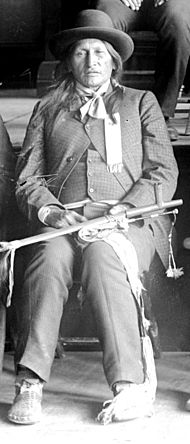Spotted Elk facts for kids
Quick facts for kids
Spotted Elk
|
|
|---|---|
| Heȟáka Glešká | |

Spotted Elk in 1888
|
|
| Miniconjou, Lakota Sioux leader | |
| Preceded by | Lone Horn (Heh-won-ge-chat or Ha-wón-je-tah – aka One Horn) |
| Personal details | |
| Born | 1826 (approx) |
| Died | December 29, 1890 (aged 64 approx) Wounded Knee Creek, Pine Ridge Indian Reservation (Lakota:Chankwe Opi Wakpala, Wazí Aháŋhaŋ Oyáŋke), South Dakota, U.S. |
| Cause of death | Killed, Wounded Knee Massacre |
| Resting place | Wounded Knee Monument, Wounded Knee Creek |
| Parent | Lone Horn (father) |
| Nickname | Big Foot (Si Tȟaŋka) |
Spotted Elk (whose name in Lakota was Uŋpȟáŋ Glešká) was a respected chief of the Miniconjou Lakota Sioux people. He was born around 1826. He became chief after his father, Lone Horn, passed away. Spotted Elk was known for his skills in both war and making peace. A soldier from the U.S. Army gave him the nickname Big Foot (Si Tȟáŋka).
Sadly, in 1890, Spotted Elk and many members of his tribe were killed by the U.S. Army. This happened at Wounded Knee Creek in South Dakota. This terrible event is now known as the Wounded Knee Massacre.
Contents
Early Life of Spotted Elk
Spotted Elk was born in about 1826. His father was Chief Lone Horn, a leader of the Lakota Sioux. Spotted Elk's family belonged to the Miniconjou group. This group was part of the larger Teton Lakota (Sioux) nation. When his father died in 1877, Spotted Elk became the new chief of his tribe.
Chief Spotted Elk's Leadership
A Skilled Peacemaker
As a chief, Spotted Elk, also known as 'Big Foot', was seen as a man who loved peace. He was famous among his people for being good at politics and diplomacy. This means he was skilled at solving big arguments. Other Lakota groups often asked for his help to settle their disagreements.
Working with Other Chiefs
In the 1870s, Spotted Elk joined forces with other important Lakota chiefs. These included Sitting Bull and Crazy Horse. They worked together against the U.S. Army. Spotted Elk's tribe, the Miniconjou, faced hard times during the Great Sioux War of 1876-77. After the war, they had to surrender.
Life on the Reservation
After the Sioux Wars, the U.S. government moved the Miniconjou people to the Cheyenne River Indian Reservation in South Dakota. Spotted Elk encouraged his people to adapt to this new way of life. He wanted them to learn farming and build schools for their children. He was one of the first Native American leaders to grow corn using government methods. Spotted Elk also believed in being peaceful with white settlers.
The Ghost Dance Movement
A New Hope for the Lakota
Life on the reservations was very difficult for the Lakota. They struggled to survive. Sometimes, government agents were dishonest and stole supplies meant for the Lakota. By 1889, the people felt hopeless and desperately wanted change.
A new religious movement called the Ghost Dance offered a solution. It was started by a Paiute prophet named Wovoka. Spotted Elk and his people became very strong believers in the Ghost Dance. This ceremony arrived among them in the spring of 1890. Even though reservation rules made practicing this religion illegal, it spread quickly. Government agents became worried. Some stopped the dances, while others asked for soldiers to restore order.
Seeking Safety with Red Cloud
On December 20, 1890, Sitting Bull was killed on the Standing Rock Reservation. His followers then sought safety with Chief Spotted Elk. Spotted Elk worried about his people being arrested. So, he led his group south to the Pine Ridge Reservation in South Dakota. He went there because Chief Red Cloud had invited him. Red Cloud hoped Spotted Elk could help make peace. Spotted Elk's group traveled with a white flag, showing they did not want to fight. During the journey, Spotted Elk became very sick with pneumonia.
Death at Wounded Knee Massacre
Peaceful Surrender
On December 28, 1890, soldiers from the 7th Cavalry found Spotted Elk's group. Even though he was very sick, Spotted Elk peacefully surrendered with his people. The soldiers took them into custody. They were escorted to a campsite near Wounded Knee Creek on the Pine Ridge Reservation. There, they were told to set up camp.
The Wounded Knee Massacre
The night before the massacre, a military leader named Colonel James W. Forsyth arrived. He ordered his men to place four Hotchkiss cannons around the Lakota camp.
On the morning of December 29, 1890, Forsyth's soldiers entered the camp. They demanded that the Lakota give up their weapons. During this tense moment, a gun was fired. It is believed a deaf man, Black Coyote, might have fired it because he didn't hear the command to put down his rifle. A large gunfight quickly started. The U.S. forces killed more than 250 Lakota people. Most of those killed were women and children who were not fighting. Spotted Elk was among those who died that day.
See also
 In Spanish: Si Tanka para niños
In Spanish: Si Tanka para niños

